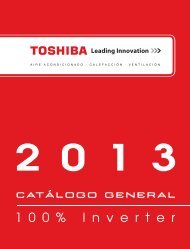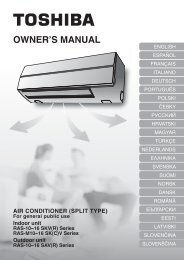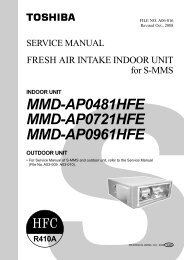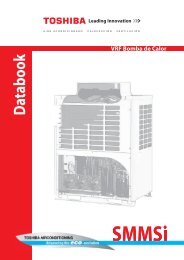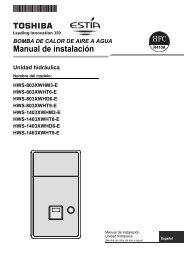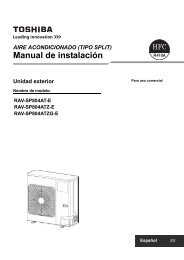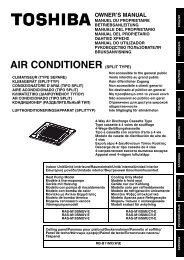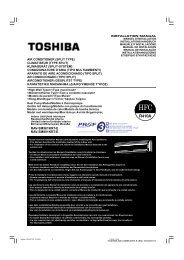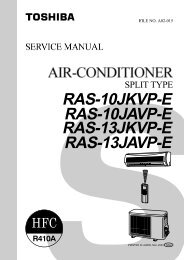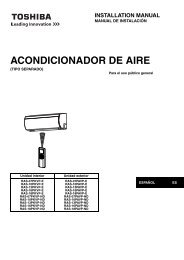SERVICE MANUAL - Alarko Carrier
SERVICE MANUAL - Alarko Carrier
SERVICE MANUAL - Alarko Carrier
Create successful ePaper yourself
Turn your PDF publications into a flip-book with our unique Google optimized e-Paper software.
Item<br />
7. Winding/Coil<br />
heating control<br />
Operation flow and applicable data, etc.<br />
When the outdoor temperature is low, the windings/<br />
coils are heated to ensure compressor reliability.<br />
Description<br />
Winding/Coil heating is performed when<br />
the following conditions are met.<br />
Outdoor temperature To<br />
12˚C<br />
11˚C<br />
2˚C<br />
1˚C<br />
Winding/Coil<br />
heating amount<br />
OFF<br />
10W<br />
20W<br />
Condition 1 :<br />
When the discharge sensor temperature<br />
(Td) is less than 30°C.<br />
Condition 2 :<br />
When 2 hours or more have elapsed after<br />
cooling, dry or heating operation stops.<br />
Condition 3 :<br />
When the outdoor sensor temperature<br />
(To) is as shown in the left figure.<br />
8. Defrost control<br />
(Only in heating<br />
operation)<br />
Outdoor heat exchanger temperature<br />
–5˚C<br />
–7˚C<br />
–20˚C<br />
(This function removes frost adhered to the outdoor<br />
heat exchanger.)<br />
The temperature sensor of the outdoor heat exchanger<br />
(Te sensor) judges the frosting status of the<br />
outdoor heat exchanger and the defrost operation is<br />
performed with 4-way valve reverse defrost system.<br />
Start of heating operation<br />
0’ 10’ 15’ 27’40” 34’<br />
*<br />
A zone<br />
B zone<br />
Operation time<br />
(Minute)<br />
C zone<br />
* The minimum value of Te sensor 10 to 15 minutes<br />
after start of operation is stored in memory as Te0.<br />
The necessity of defrost operation is<br />
detected by the outdoor heat exchanger<br />
temperature. The conditions to detect the<br />
necessity of defrost operation differ in A,<br />
B, or C zone each. (Table 1)<br />
<br />
• Defrost operation in A to C zones<br />
1) Stop operation of the compressor for<br />
20 seconds.<br />
2) Invert (OFF) 4-way valve 10 seconds<br />
after stop of the compressor.<br />
3) The outdoor fan stops at the same time<br />
when the compressor stops.<br />
4) When temperature of the indoor heat<br />
exchanger becomes 38°C or lower,<br />
stop the indoor fan.<br />
<br />
• Returning conditions from defrost<br />
operation to heating operation<br />
1) Temperature of outdoor heat exchanger<br />
rises to +8°C or higher.<br />
2) Temperature of outdoor heat exchanger<br />
is kept at +5°C or higher for 80 seconds.<br />
3) Defrost operation continues for<br />
15 minutes.<br />
A zone<br />
B zone<br />
C zone<br />
Table 1<br />
When Te0 - TE ≥ 2.5 continued for 2 minutes in A zone,<br />
defrost operation starts.<br />
When the operation continued for 2 minutes in B zone,<br />
defrost operation starts.<br />
When Te0 - TE ≥ 3 continued for 2 minutes in C zone,<br />
defrost operation starts.<br />
<br />
1) Stop operation of the compressor for<br />
approx. 50 seconds.<br />
2) Invert (ON) 4-way valve approx. 40<br />
seconds after stop of the compressor.<br />
3) The outdoor fan starts rotating at the<br />
same time when the compressor starts.<br />
– 58 –



